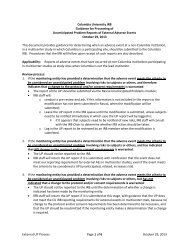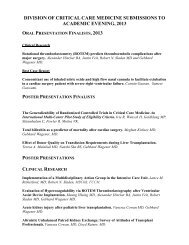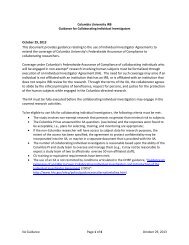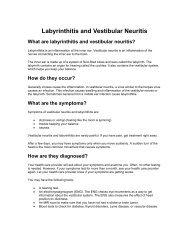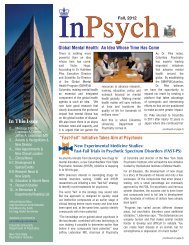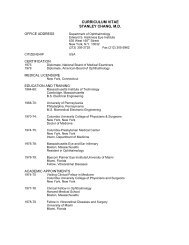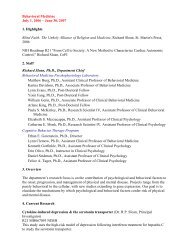news PS - Columbia University Medical Center
news PS - Columbia University Medical Center
news PS - Columbia University Medical Center
You also want an ePaper? Increase the reach of your titles
YUMPU automatically turns print PDFs into web optimized ePapers that Google loves.
of the patient’s upper airway during sleep, to accurately pinpoint the area<br />
of obstruction. Dr. Ahn is among the first to use an endoscope equipped<br />
with a tiny video camera to highlight problem areas while a patient sleeps.<br />
The robotic procedure was adapted from a technique pioneered at the<br />
<strong>University</strong> of Pennsylvania to remove cancer from the back of the tongue.<br />
Dr. Ahn completed a rigorous training program to gain certification for<br />
the surgery. Presently, he is the only surgeon in New York specializing in<br />
the robotic treatment of obstructive sleep apnea.<br />
Dr. Ahn cautions patients that sleep apnea can return if they do not keep<br />
their weight under control, but most patients lose weight after surgery.<br />
Forestalling Lymphedema, a Preventive Strategy<br />
By Dan Harvey<br />
After surviving breast cancer, many patients<br />
must battle lymphedema, a common side effect of<br />
breast cancer surgery that causes painful, debilitating,<br />
and disfiguring swelling in the arms.<br />
Breast cancer specialists at NewYork-Presbyterian/<strong>Columbia</strong><br />
<strong>University</strong> <strong>Medical</strong> <strong>Center</strong><br />
now have a way to detect lymphedema early<br />
– before patients notice symptoms and when<br />
treatments are more effective. “Clinicians can<br />
now be more proactive than reactive,” says<br />
Sheldon Feldman, M.D., the Vivian L. Milstein<br />
Associate Professor of Clinical Surgery and<br />
chief of breast surgery.<br />
Lymphedema is a common side effect of<br />
lymph node removal in breast cancer treatment,<br />
but doctors cannot predict when, or if, it will<br />
occur. Lymphedema can appear immediately<br />
after treatment or it can take months, or even<br />
years, to develop.<br />
Clinicians can now use bioimpedance spectroscopy<br />
to detect the earliest signs of lymphedema.<br />
The small portable device applies a mild electric<br />
current to the upper arm and measures the amount<br />
of fluid in the limb. “The patient might be asymptomatic<br />
– that is, no visible swelling – but we can<br />
detect increased volume,” says Dr. Feldman.<br />
The test is non-invasive and painless and best<br />
serves those at the highest risk: patients with invasive<br />
breast cancer who undergo surgery, radiation<br />
therapy, and chemotherapy. NYP/<strong>Columbia</strong> is the<br />
only academic medical center in New York that<br />
offers a lymphedema prevention program.<br />
Lymphedema cannot be cured, but early<br />
detection can forestall the condition. “By the<br />
time swelling is visible, it may be too late to<br />
provide optimal treatment,” Dr. Feldman says.<br />
“But if it’s detected early, we can pre-empt<br />
lymphedema development with therapy and<br />
avoid long-lasting effects.”<br />
Therapy typically includes several visits with<br />
a physical therapist for decongestive therapy,<br />
which involves massage, wrappings, compression<br />
bandages, and support garments. Treatment<br />
typically lasts for a month and reduces<br />
swelling in most cases.<br />
In the year since the program started, several<br />
patients have been identified with subclinical<br />
levels of lymphedema. Before the program<br />
began, testing was typically performed only<br />
after swelling was noticeable. Now, Dr. Feldman<br />
says, “Even before a patient has lymph<br />
node surgery, we do a baseline study to determine<br />
normal fluid levels. We then follow up on<br />
a three- to six-month basis after surgery. We can<br />
see very quickly if the levels increase.”<br />
Surgeons are also working to prevent lymphedema<br />
by becoming more selective about<br />
removing lymph nodes. Until the mid-1990s,<br />
most or all lymph nodes in the armpit were<br />
removed to prevent the spread of cancer to<br />
other organs. Then techniques were developed<br />
that allowed surgeons to determine if some of<br />
these lymph nodes could be spared. If the sentinel<br />
lymph node – the node closest to the cancer<br />
– was clear, the other nodes were spared. If the<br />
sentinel lymph node contained tumor cells, the<br />
surrounding lymph nodes were removed. “We<br />
now understand that even if the sentinel node<br />
In the two months after her procedure, Mrs. Oderwald lost 30 pounds,<br />
which she attributes to her newfound energy. “When you’re tired, I think<br />
you go for the wrong foods,” she says. “I’m now out walking the dogs<br />
every night, I’m eating better, and the weight’s come off.”<br />
“Sleep apnea that stems from tongue base has troubled me for the 15<br />
years I’ve been doing sleep apnea surgery,” Dr. Ahn says. “But I think<br />
now we have a technique that is finally capable of helping the majority<br />
of our patients.”<br />
More information is available from Dr. Ahn, 212-714-9494.<br />
has cancer, it may not be necessary to remove<br />
additional lymph nodes,” says Dr. Feldman.<br />
A technique called reverse arm mapping<br />
also has helped surgeons reduce the number of<br />
nodes removed. “Mapping better defines the<br />
function of the lymph nodes in the armpit. Two<br />
nodes may be close together, but one affects the<br />
arm while the other affects the breast,” says Dr.<br />
Feldman. In reverse arm mapping, the lymph<br />
nodes related to the arm are identified with a<br />
special dye so they can be spared. “This reduces<br />
the risk of lymphedema,” Dr. Feldman says.<br />
Soon, <strong>Columbia</strong> breast surgeons also will<br />
start offering patients at the highest risk of<br />
lymphedema a new surgical technique to prevent<br />
lymphedema. These patients have more<br />
advanced breast cancer with lymph node<br />
metastases that requires complete lymph node<br />
dissection and radiation treatment of the armpit<br />
region. The risk of developing lymphedema<br />
after this treatment is 40 percent.<br />
To reduce that risk, <strong>Columbia</strong> surgeons will<br />
use dye to identify the lymphatic vessels from<br />
the arm and then connect the vessels to a branch<br />
of the axillary vein after the lymph nodes are<br />
removed. “This will re-establish the lymph flow<br />
and significantly reduce the risk of lymphedema<br />
developing,” Dr. Feldman says.<br />
“These are important advances that we think<br />
will reduce the incidence of lymphedema and help<br />
us improve quality of life for survivors.”<br />
More information is available from the Clinical<br />
Breast Cancer Program, 212-305-9676.<br />
Spring 2012 <strong>Columbia</strong>Medicine 17



